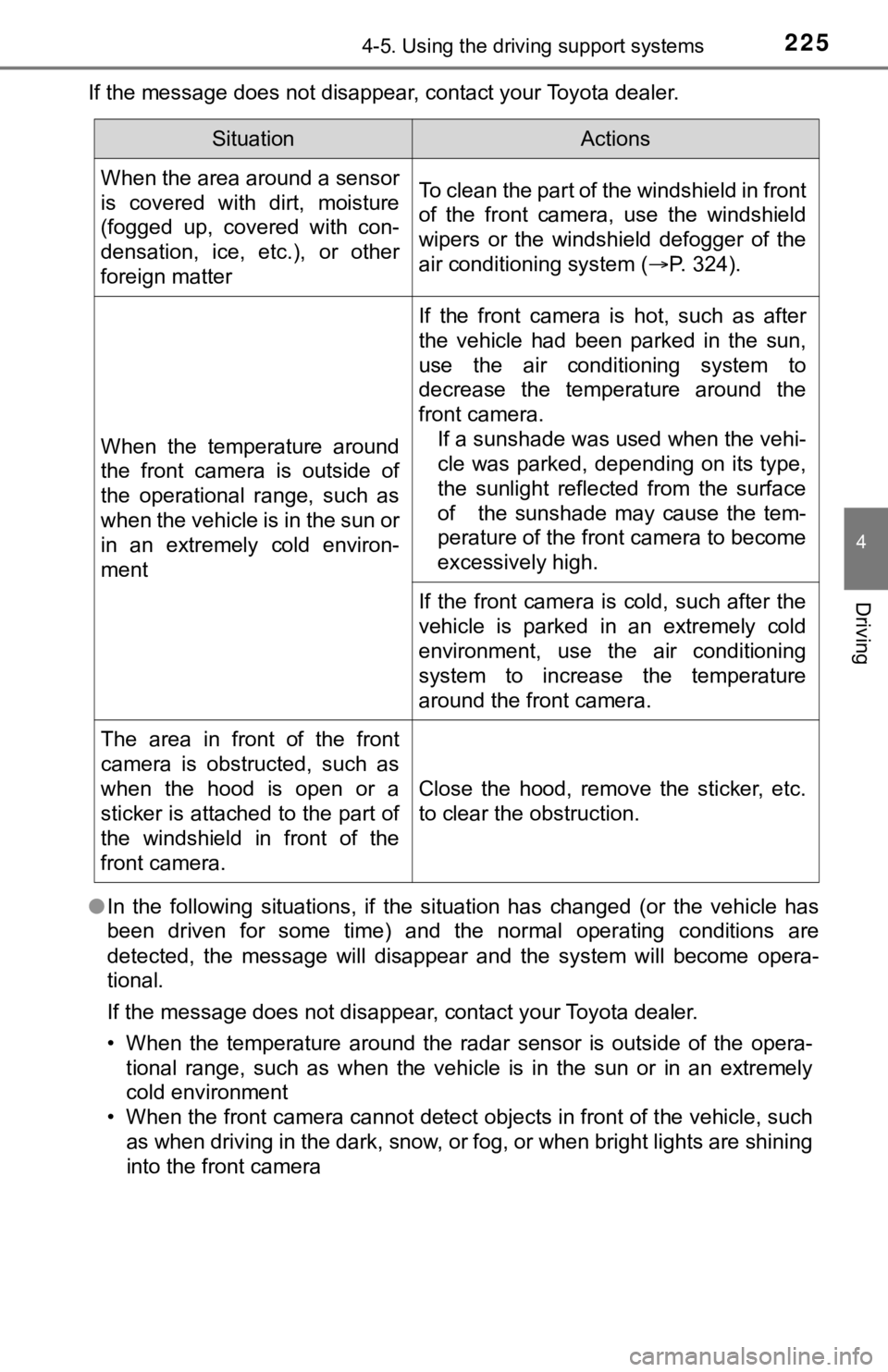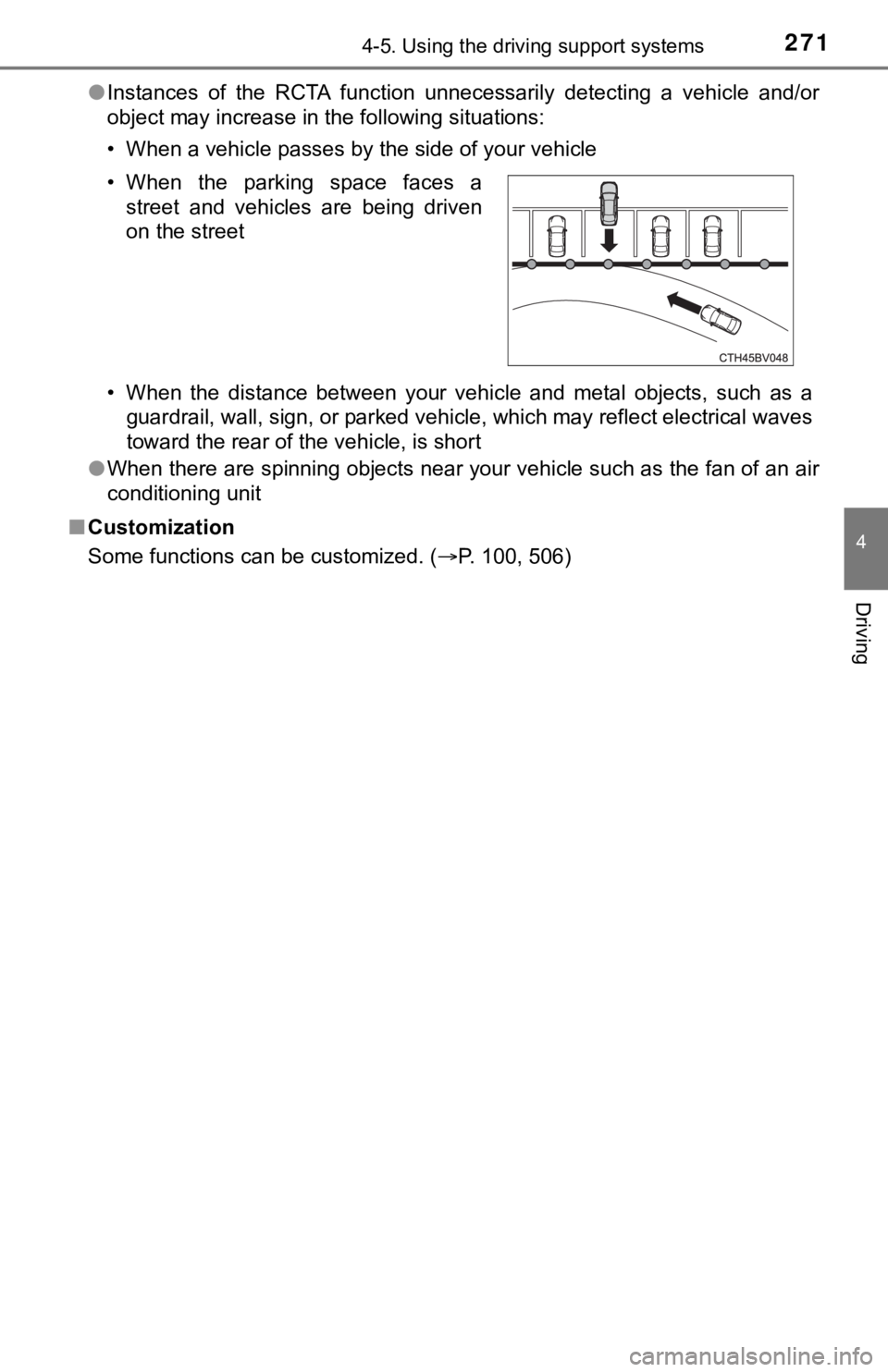air conditioning TOYOTA AVALON 2021 Owners Manual (in English)
[x] Cancel search | Manufacturer: TOYOTA, Model Year: 2021, Model line: AVALON, Model: TOYOTA AVALON 2021Pages: 548, PDF Size: 13.4 MB
Page 4 of 548

TABLE OF CONTENTS4
4-5. Using the driving
support systems
Toyota Safety Sense P ..... 218
PCS
(Pre-Collision System) .... 226
LDA (Lane Departure Alert
with steering control) ....... 237
Dynamic radar cruise
controlwith full-speed
range ............................... 247
BSM
(Blind Spot Monitor) ........ 260
• BSM function ................ 264
• RCTA function .............. 267
Rear Camera Detection
function (vehicles with
panoramic view
monitor) ........................... 272
Intuitive parking assist ....... 276
Intelligent Clearance
Sonar (ICS) ..................... 284
Driving mode select
switches .......................... 305
Driving assist systems....... 309
4-6. Driving tips
Winter driving tips.............. 3175-1. Using the
air conditioning
system and defogger
Automatic air conditioning
system ............................. 322
Heated steering wheel/
seat heaters/seat
ventilators ........................ 329
5-2. Using the interior lights
Interior lights list................. 332
• Interior light ................... 333
• Personal lights............... 333
• Ambient lights................ 334
5-3. Using the storage
features
List of storage features ...... 335
• Glove box ...................... 336
• Console box .................. 336
• Bottle holders ................ 337
• Cup holders ................... 338
• Auxiliary boxes .............. 339
• Open tray ...................... 340
Trunk features ................... 341
5-4. Other interior features
Other interior features........ 342
• Sun visors ..................... 342
• Vanity mirrors ................ 342
• Power outlet .................. 343
• USB charging ports ....... 344
• Wireless charger ........... 346
• Armrest.......................... 355
• Assist grips .................... 355
• Coat hooks .................... 356
Garage door opener .......... 3575Interior features
Page 5 of 548

5
1
8 7 5 4
3
2
9
6
6-1. Maintenance and care
Cleaning and protecting
the vehicle exterior .......... 366
Cleaning and protecting
the vehicle interior ........... 369
6-2. Maintenance
Maintenance
requirements ................... 372
General maintenance ........ 374
Emission inspection and
maintenance (I/M)
programs ......................... 378
6-3. Do-it-yourself
maintenance
Do-it-yourself service
precautions ..................... 379
Hood.................................. 381
Positioning a floor jack ...... 382
Engine compartment ......... 383
Tires .................................. 394
Tire inflation pressure........ 408
Wheels .............................. 411
Air conditioning filter .......... 413
Electronic key battery ........ 415
Checking and replacing
fuses ............................... 418
Light bulbs ......................... 4217-1. Essential information
Emergency flashers ........... 424
If your vehicle has to be
stopped in an
emergency....................... 425
If the vehicle is trapped
in rising water .................. 426
7-2. Steps to take in
an emergency
If your vehicle needs to
be towed .......................... 427
If you think something
is wrong ........................... 432
Fuel pump shut off
system ............................. 433
If a warning light turns on
or a warning buzzer
sounds ............................. 434
If a warning message is
displayed ......................... 444
If you have a flat tire .......... 449
If the engine will
not start ........................... 461
If the electronic key does
not operate properly ........ 463
If the vehicle battery is
discharged ....................... 466
If your vehicle overheats.... 471
If the vehicle becomes
stuck ................................ 474
6Maintenance and care7When trouble arises
Page 19 of 548

19Pictorial index
Parking brake switch . . . . . . . . . . . . . . . . . . . . . . . . . . . . . . . P. 196
Applying/releasing . . . . . . . . . . . . . . . . . . . . . . . . . . . . . . P. 196, 197
Precautions for winter season . . . . . . . . . . . . . . . . . . . . . . . . . P. 318
Warning light/warning buzzer/
warning message . . . . . . . . . . . . . . . . . . . . . . . . . . . . . . . P. 199, 434
Turn signal lever . . . . . . . . . . . . . . . . . . . . . . . . . . . . . . . . . . P. 195
Headlight switch . . . . . . . . . . . . . . . . . . . . . . . . . . . . . . . . . . P. 202
Headlights/side marker lights/parking lights/tail lights/
license plate lights/daytime running lights . . . . . . . . . . . . . . . . P. 202
Windshield wiper and washer switch . . . . . . . . . . . . . . . . . P. 210
Usage . . . . . . . . . . . . . . . . . . . . . . . . . . . . . . . . . . . . . . . . . . . P. 210
Adding washer fluid . . . . . . . . . . . . . . . . . . . . . . . . . . . . . . . . . P. 393
Emergency flasher switch . . . . . . . . . . . . . . . . . . . . . . . . . . P. 424
Hood lock release lever. . . . . . . . . . . . . . . . . . . . . . . . . . . . . P. 381
Tilt and telescopic steering lock release lever
*1 . . . . . . . . P. 153
Tilt and telescopic steering control switch
*1 . . . . . . . . . . . P. 153
Adjustment . . . . . . . . . . . . . . . . . . . . . . . . . . . . . . . . . . . . . . . . P. 153
Driving position memory . . . . . . . . . . . . . . . . . . . . . . . . . . . . . P. 146
Air conditioning system . . . . . . . . . . . . . . . . . . . . . . . . . . . . P. 322
Usage . . . . . . . . . . . . . . . . . . . . . . . . . . . . . . . . . . . . . . . . . . . P. 322
Rear window defogger . . . . . . . . . . . . . . . . . . . . . . . . . . . . . . . P. 324
Audio Plus
*1, 2
Premium Audio*1, 2
*1: If equipped
*2: Refer to “NAVIGATION AND MULTIMEDIA SYSTEM OWNER’S MANUAL”.
4
5
6
7
8
9
10
11
12
Page 225 of 548

2254-5. Using the driving support systems
4
Driving
If the message does not disappear, contact your Toyota dealer.
●In the following situations, if the situation has changed (or the vehicle has
been driven for some time) and the normal operating conditions are
detected, the message will disappear and the system will become opera-
tional.
If the message does not disappear, contact your Toyota dealer.
• When the temperature around the radar sensor is outside of the opera-
tional range, such as when the vehicle is in the sun or in an extremely
cold environment
• When the front camera cannot detect objects in front of the vehicle, such
as when driving in the dark, snow, or fog, or when bright lights are shining
into the front camera
SituationActions
When the area around a sensor
is covered with dirt, moisture
(fogged up, covered with con-
densation, ice, etc.), or other
foreign matterTo clean the part of the windshield in front
of the front camera, use the windshield
wipers or the windshield defogger of the
air conditioning system (P. 324).
When the temperature around
the front camera is outside of
the operational range, such as
when the vehicle is in the sun or
in an extremely cold environ-
ment
If the front camera is hot, such as after
the vehicle had been parked in the sun,
use the air conditioning system to
decrease the temperature around the
front camera.
If a sunshade was used when the vehi-
cle was parked, depending on its type,
the sunlight reflected from the surface
of the sunshade may cause the tem-
perature of the front camera to become
excessively high.
If the front camera is cold, such after the
vehicle is parked in an extremely cold
environment, use the air conditioning
system to increase the temperature
around the front camera.
The area in front of the front
camera is obstructed, such as
when the hood is open or a
sticker is attached to the part of
the windshield in front of the
front camera.
Close the hood, remove the sticker, etc.
to clear the obstruction.
Page 271 of 548

2714-5. Using the driving support systems
4
Driving
●Instances of the RCTA function unnecessarily detecting a vehicle and/or
object may increase in the following situations:
• When a vehicle passes by the side of your vehicle
• When the distance between your vehicle and metal objects, such as a
guardrail, wall, sign, or parked vehicle, which may reflect electrical waves
toward the rear of the vehicle, is short
●When there are spinning objects near your vehicle such as the fan of an air
conditioning unit
■Customization
Some functions can be customized. (P. 100, 506) • When the parking space faces a
street and vehicles are being driven
on the street
Page 275 of 548

2754-5. Using the driving support systems
4
Driving
●In some situations, such as the following, the rear camera detection function
<00500044005c000300520053004800550044005700480003004800590048005100030057004b00520058004a004b00030057004b004800550048000300440055004800030051005200030053004800470048005600570055004c0044005100560003004c00
5100030057004b00480003004700480057004800460057004c[on area.
• When a three dimensional object, such as a pole, traffic cone, fence, or
parked vehicle, is detected
• When a moving object, such as a car or motorcycle is detected
• When backing up toward moving objects such as flags or puddles, or air-
borne matter, such as smoke, steam, rain, or snow
• When there is a pattern on the road, due to the road being made of cob-
blestone or gravel or having tram rails, traces of repair, white lines,
pedestrian crossings or fallen leaves on the surface
• When backing up on a metal cover (grating), such as those used for
drainage ditches
• When backing up toward the roadside or a bump in the road
• When an object is reflected in a puddle or on a wet road surface
• When there are shadows on the road
• When backing up over a bump in the road
• If the vehicle is significantly tilted, such as when carrying a heavy load
• When backing up toward an incline/decline
• If the suspension has been modified or tires of a size other than specified
are installed
• If the rear of the vehicle is raised or lowered due to the carried load
• If an electronic component, such as a backlit license plate or rear fog
light, is installed near the rear camera
• If a bumper protector, such as an additional trim strip, is installed to the
rear bumper
• If the orientation of the rear camera has been changed due to a collision
or other impact, or removal and installation
• If a towing eyelet is installed to the rear of the vehicle
• When the rear camera is obscured (dirt, snow, ice, etc. are attached) or
scratched
• When water is flowing over the rear camera lens
• If there is a flashing light in the detection area, such as the emergency
flashers of another vehicle
■Situations in which the rear camera detection function may be difficult to
notice
●If buzzer may be difficult to hear if the surrounding area is noisy, the volume
of the audio system volume is high, the air conditioning system is being
used, etc.
●If the temperature in the cabin is extremely high or low, the audio system
screen may not operate correctly.
Page 280 of 548

2804-5. Using the driving support systems
■The intuitive parking assist can be operated when
●Front corner sensors:
• The engine switch is in IGNITION ON mode.
• The shift lever is in other than P.
• The vehicle speed is less than about 6 mph (10 km/h).
●Front center sensors:
• The engine switch is in IGNITION ON mode.
• The shift lever is in other than P or R.
• The vehicle speed is less than about 6 mph (10 km/h).
●Rear corner and rear center sensors:
• The engine switch is in IGNITION ON mode.
• The shift lever is in R.
• The vehicle speed is less than about 6 mph (10 km/h).
■Intuitive parking assist display
When an object is detected while the Toyota parking assist monitor or pan-
oramic view monitor is in use, the warning indicator will appear in the upper
part of the screen even if the display setting has been set to off.
■Sensor detection information
●The sensor’s detection areas are limited to the areas around the vehicle’s
bumper.
●Depending on the shape of the object and other factors, the detection dis-
tance may shorten, or detection may be impossible.
●Objects may not be detected if they are too close to the sensor.
●There will be a short delay between object detection and display. Even at
slow speeds, there is a possibility that the object will come within the sen-
<00560052005500b600560003004700480057004800460057004c00520051000300440055004800440056000300450048004900520055004800030057004b004800030047004c00560053004f0044005c0003004c005600030056004b0052005a0051000300
440051004700030057004b0048000300450058005d005d0048[r sounds.
●Thin posts or objects lower than the sensor may not be detected when
approached, even if they have been detected once.
●It might be difficult to hear beeps due to the volume of audio system or air
flow noise of the air conditioning system.
■If a battery terminal has been disconnected and reconnected
The system needs to be initialized.
To initialize the system, drive the vehicle straight ahead for 5 seconds or more
at a speed of approximately 22 mph (35 km/h) or more.
■If “Parking Assist Unavailable Clean Parking Assist Sensor” is displayed
on the multi-information display
A sensor may be dirty or covered with snow or ice. In such cases, if it is
removed from the sensor, the system should return to normal.
Also, due to the sensor being frozen at low temperatures, a malfunction dis-
play may appear or an object may not be detected. If the sensor thaws out,
the system should return to normal.
Page 302 of 548

3024-5. Using the driving support systems
■Situations in which the system may operate even though there is no
possibility of a collision
In some situations such as the following, the Rear Cross Traffic Auto Brake
function may operate even though there is no possibility of a collision.
●When there are spinning objects near your vehicle such as the fan of an air
conditioning unit
●When water is splashed or sprayed toward the rear bumper, such as from a
sprinkler ●When the parking space faces a street
and vehicles are being driven on the
street
●When a detected vehicle turns while
approaching the vehicle
●When a vehicle passes by the side of
your vehicle
●When the distance between your vehicle
and metal objects, such as a guardrail,
wall, sign, or parked vehicle, which may
reflect electrical waves toward the rear
of the vehicle, is short
Page 307 of 548

3074-5. Using the driving support systems
4
Driving
Eco drive mode
Use Eco drive mode to help achieve low fuel consumption during
trips that involve frequent accelerating.
When the “ECO” switch is pressed, the “ECO MODE” indicator comes on
in the multi-information display.
Sport mode
• SPORT S mode
Controls the transmission and engine to provide quick, powerful
acceleration. This mode is suitable for when agile driving
response is desired, such as when driving on roads with many
curves.
When not in SPORT S mode, if the “SPORT S/S+” switch is pressed,
the “SPORT S” indicator will come on in the multi-information display.
• SPORT S+ mode
Helps to ensure steering performance and driving stability by
simultaneously controlling the steering and suspension in addi-
tion to the transmission and engine. Suitable for sportier driving.
When in SPORT S mode, if the “SPORT S/S+” switch is pressed, the
“SPORT S+” indicator will come on in the multi-information display.
FunctionSetting
Powertrain
Normal
Power
Eco
ChassisNormal
Sport
Air conditioning systemNormal
Eco
2
3
Page 308 of 548

3084-5. Using the driving support systems
■Operation of the air conditioning system in Eco drive mode
Eco drive mode controls the heating/cooling operations and fan speed of the
air conditioning system to enhance fuel efficiency (P. 322). To improve air
conditioning performance, adjust the fan speed or turn off Eco drive mode.
■Automatic deactivation of sport mode and custom mode
If the engine switch is turned off after driving in sport mode or custom mode,
the drive mode will be changed to normal mode.